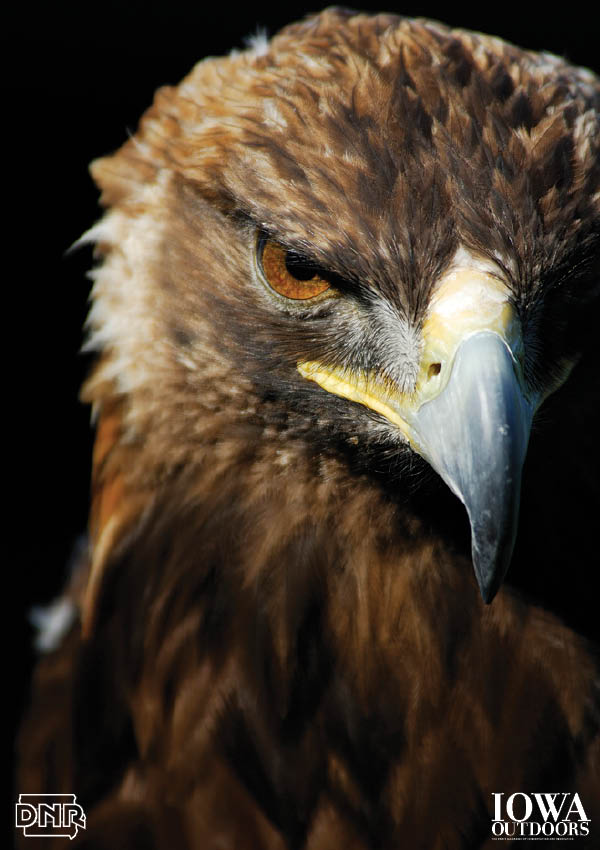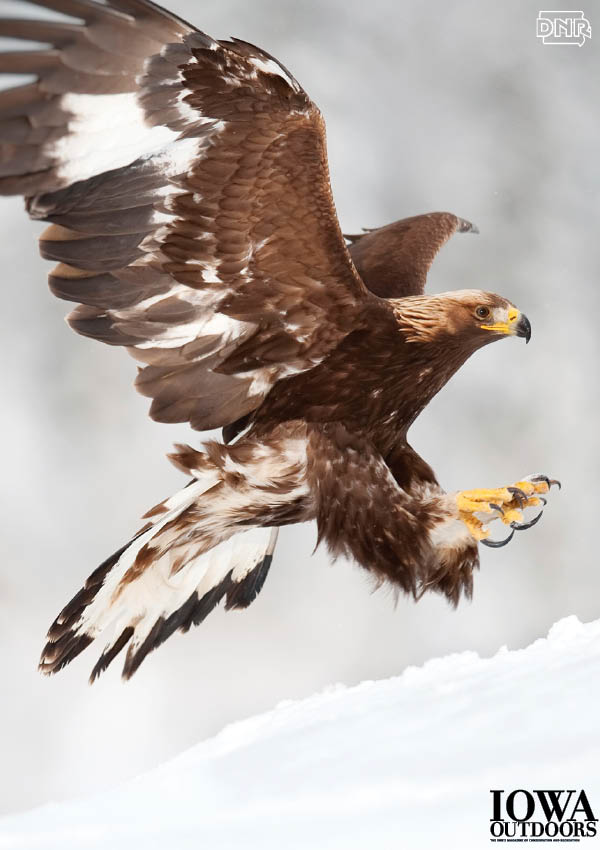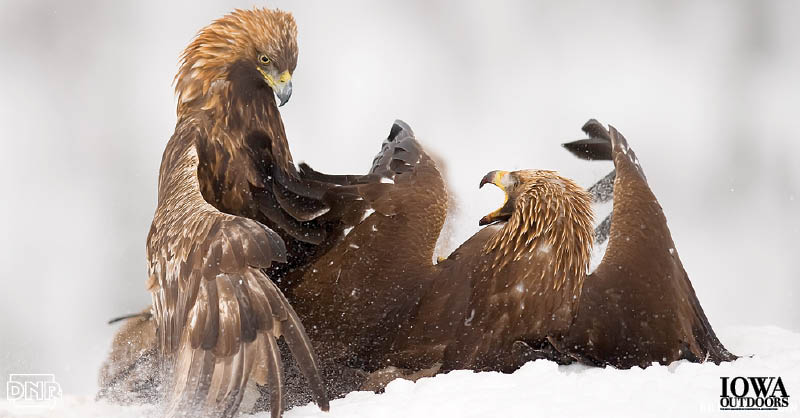 By Ty Smedes
By Ty Smedes
From the January/February 2016 issue of Iowa Outdoors magazine
It’s a beautiful late January morning in Allamakee County, with clear blue skies and nearly calm winds. We’re about to leave Yellow River State Forest’s Little Paint Campground when three large raptors float over the bluff and into view. We’ve already counted several bald eagles, but one of these birds seems different. Although it has the chocolate color of a juvenile bald eagle, it has white patches mid-wing and drifts with wings extended in a slight “V.”
“It’s a golden eagle!” exclaims Jerry Toll, one of my two survey companions and expert raptor identifier. Veronica Mecko, my other companion, quickly agrees, and we log our first golden eagle of the 11th Annual Tri-State Golden Eagle Survey.
And that’s the fun part. Most outdoor lovers haven’t a clue that northeastern Iowa holds golden eagles from November through March—part of a population in the bluff country of Iowa, Minnesota, Wisconsin and Illinois. But they are here, and Iowans are encouraged to help monitor the population by taking part in the survey, always the third week of January.
The surveys are organized by Scott Mehus, Education Director at the National Eagle Center, in Wabasha, Minn., who started the effort more than a decade ago.
As our survey team cruises another road along the middle of Iowa survey route number 2, we slowly top a bluff and enter another valley where we spot five eagles drifting above the far ridge. Three are bald eagles traveling alone, but the other two have us instantly spellbound.
An immature golden eagle is aggressively pursuing an immature bald eagle. Time after time the bald swoops at the golden—talons extended—and time after time he just misses the mark. We gaze in fascination as the aerial confrontation plays out, continuing far down the valley, eventually over the ridge and out of sight.
When I relate this spectacle to Mehus, he explains, “Bald eagles don’t go after golden eagles or visa-versa unless they are competing for prey. It’s likely the golden had captured a small animal like a squirrel, and the bald eagle was simply trying to steal it away. Predator confrontations over prey often occur, and this was surely such an incident,” he says. And it could have been, but for us, the eagles were too distant to see if the golden was indeed clutching prey in its talons.
An Annual Golden Eagle Survey Takes Flight
Interested in wildlife as a youngster, Mehus attended Vermillion College in Ely Minn., and when his professor took the class down to Hawk Ridge near Duluth to view the fall raptor migration, he fell in love with it. After college, he worked for the Minnesota DNR non-game crew, and hearing that southeastern Minnesota and western Wisconsin were reliable places to see golden eagles during winter, Mehus wondered if there were more goldens farther down the river.
“Hawk Ridge averages 150 to 200 golden eagles migrating by each fall, and it never made sense to me they were western birds that simply wandered east. There just weren’t any ferruginous hawks, prairie falcons or other western raptors that seemingly got off-course and ended up by Hawk Ridge. We just rarely saw any of these species migrating by. I kept finding more golden eagles up and down the river, which led me to start the golden eagle survey in 2005 with 24 friends,” he says.
 Lansing resident and biologist Ric Zarwell is an independent bird researcher. Like many, his first encounters with golden eagles “were in the western U.S. as a kid, while on vacation with my parents. Later, I began noticing golden eagles in the driftless area of northeast Iowa during winter. Then, about 10 years ago I got a call from Mehus, asking if I would participate in the first annual golden eagle survey in Allamakee County.”
Lansing resident and biologist Ric Zarwell is an independent bird researcher. Like many, his first encounters with golden eagles “were in the western U.S. as a kid, while on vacation with my parents. Later, I began noticing golden eagles in the driftless area of northeast Iowa during winter. Then, about 10 years ago I got a call from Mehus, asking if I would participate in the first annual golden eagle survey in Allamakee County.”
Zarwell’s wife, Betty, also participates, and since their first involvement, the couple has participated in a half-dozen more, which are always held the third Saturday in January.
“Sometimes we haven’t found any goldens, while the most we have found is four,” says Ric Zarwell.
But Mehus still had work to do.
“A lot of doubters thought I was seeing juvenile bald eagles which look similar, so initially I wanted to prove there were more goldens than people thought,” says Mehus.
“Since I knew how to correctly identify them, I thought the best thing to do was to assemble a survey group to get out on the same day and look,” he says.
Those initial surveys gained the attention of birding clubs and researchers who often doubted the survey numbers. This led to Carroll Henderson of the Minnesota DNR and Mark Martell with the Minnesota Ornithologist’s Union asking Mehus to take them scouting for goldens in about 2008.
“When we succeeded in finding goldens, it became a big deal. Afterwards we huddled up at a local restaurant and hatched a plan for the more coordinated survey effort of today, along with the idea of tracking birds
back to their natal areas,” says Mehus.
Tracking Goldens to Northern Canada
It was one thing to consistently find goldens, but it never tackled the speculation as to where the birds came from. Were they, like conventional birding wisdom suspected, wayward western birds? Or did they originate from someplace else? Technology would provide the answers. To track where these wintering goldens originated, the National Eagle Center and Minnesota Audubon, with technical help from Martell, initiated a satellite tracking endeavor. Martell had prior experience with raptor tracking and attaching small backpacks outfitted with tiny transmitters onto birds. Several goldens were captured, laden with backpack transmitters, and their every moves were followed by satellite.
And the findings were surprising indeed. The 100 to 130 goldens that overwinter in the Upper Midwest come
from the Canadian far north—the Iowa contingent coming from near Yellowknife in the Northwest Territories.
They weren’t coming from year-round populations in the American West after all.
Get Involved—Become a Golden Eagle Surveyor
Bird researcher Ric Zarwell wants more Iowans to participate in the annual eagle survey, so each of seven survey routes—from Dubuque to the Minnesota border—are well staffed by trained volunteers each year.
“I believe more survey regions could be added if more participants step forward. Northeast Iowa is a beautiful area and the annual survey could even become a family activity. Or, groups of friends could meet and have fun doing the Saturday survey. Surveyors don’t have to get up early, since the best times are between 10 a.m. and 3 p.m., after the thermals have started,” he says.
Educating people about the importance of goat prairies and other habitat is key, adds Scott Mehus of the National Eagle Center in Minnesota. Area landowners can remove cedars to open hillsides for wildlife and create more prey for goldens.
To learn more about the Golden Eagle Project or to volunteer with the survey, contact golden@nationaleaglecenter.org, visit nationaleaglecenter.org or call 1-877-332-4537.
For more, check out our Iowa Wildlife and Iowa Outdoors Magazine boards on Pinterest.
